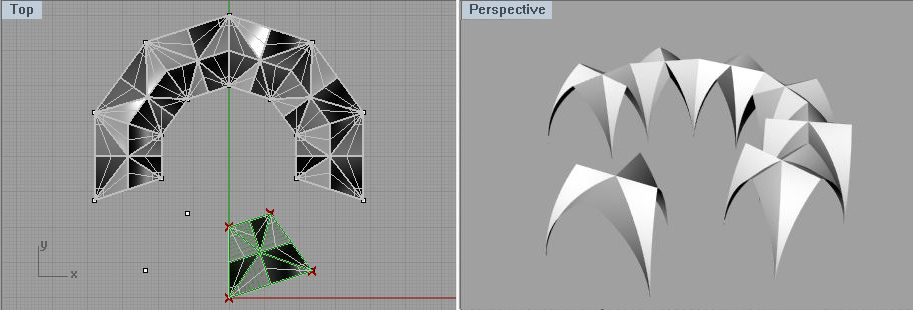1. Hello World and Simple Python Scripts
In some circumstances it may be more effective to use a Python scripting component in conjunction with other Grasshopper components. We begin with a few simple Python scripts. These first scripts are for introductory purposes and don't necessarily offer an advantage over other Grasshopper components. We will then move onto Python scripts which offer advantages over other Grasshopper options in terms of conciseness and clarity of organization. Within these examples we take advantage of libraries and related function calls to perform some tasks, such as:
a = rs.AddLine(point1, point2)
This expression defines a line "a" from the rhinoscript library
abbreviated
as "rs" and the procedure "AddLine" which creates a line from two
points. More complete documentation on Python, examples, and associated
libraries are located at the web site
http://wiki.mcneel.com/developer/python.
On the web site,
the manual http://download.rhino3d.com/IronPython/5.0/RhinoPython101/
provides a comprehensive introdexample to establish a basic
understanding .
Launch Rhino and Grasshopper, and load the file helloWorld.gh.
The file shows two Python scripts, one that
echoes to text strings and the other that adds two numbers.
First, we demonstrate a script that outputs the text string "Hello World!". This follows a tradition of introducing programming languages with a "Hello World!" back the text string "Hello World!" and a second that returns the sum of two numbers.
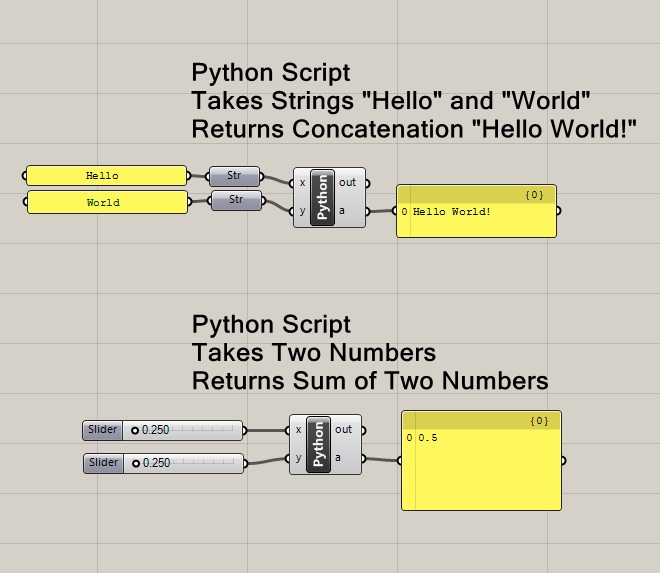
Note that the input text strings "Hello" and "World" are connected to two "Str" (string) components. The two "Str" components are in turn connected to the Python script input parameters "x" and "y". The Python script in turn returns the parameter "A", which is the text string "Hello World!".
If you modify either of the input text strings, then the output text string is modified accordingly, such as replacing the text string "World" with the text string "Virginia" in the example below:
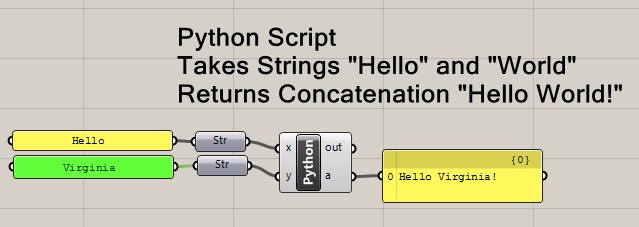
To see the Python Script in detail, double click on "VB" icon in the Grasshopper window to launch the script editor.
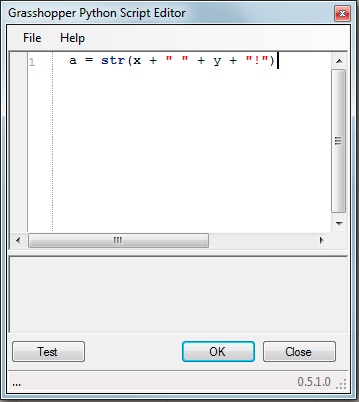
Note
that the two input arguments "x" and "y" are passed into the Python
script
component. The "String"
designation means that both "x" and "y" are a text expression
of alphanumeric characters. Note too that any
change to the value of an input variable (such as "x" or "y")
inside the Python Script component is limited in scope to be
internal to the script function. That is, the modification to
the
value of the variable internal to script function would
not change its value outside the script. Thus if we
added
the
line to the above script y = "virginia film festival". The
value
of x outside of the script would be unchanged from x = "Virginia".
Lets break down the statements on lines 94 and 95 in the Script Editor
above.
a =
str(x +
" " + y + "!")
The statement assigns a string value to variable "a" by joining
together 1. the value of the string x, 2. a blank space " ", 3. the
string y, and 4. the exclamation point "!". Note that the use of the
"+" symbol is used to add together (concatenate) the larger string from
the the strings "Hello", " ", World, "!", similar to how one might add
several numbers together.
The variable "a" is also the output variable of the script. Thus, it in
turn is directed to the input port of the yellow panel that displays
the result "Hello World!".
Now we will reconstruct the script from scratch. Go to File/New Script.
Go to the "Params" tab and in the "Input" area, select the
yellow
panel.
Drag two yellow panels with the left-mouse button into the Grasshopper
view window.
Double click on each panel, and edit the text string to
become
"Hello" on on panel and to become "World" on the
other
panel.
The result is that the panels should transform as follows.
Continuing with the "Params" tab, go to the
"Primitive"
area and select the string component symbolized by the letter "A".
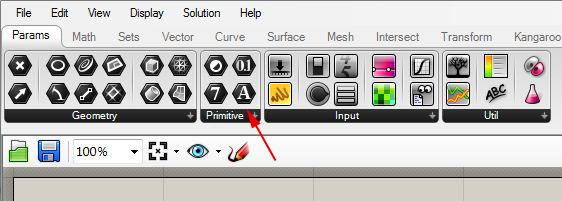
Drag two string components with the left-mouse button into the
Grasshopper view window, and connect their input ports to the output
ports of the two yellow panels.
Now go the the "Math" tab and in the "Input" area, select the blue and
yello P.

Drag
on
Python component with
the left-mouse
button into the Grasshopper view window and connect its input
ports to the output ports of the two string components.
Resize
the yellow panels by moving the mouse over any of its edges, depressing
the left-mouse button, and dragging the edge to the desired size.

Zoom into the Python component , right-click on the letter
"x",
go the the "Type hint" item, and change the type to "String". Do the
same for the letter "y" variable.
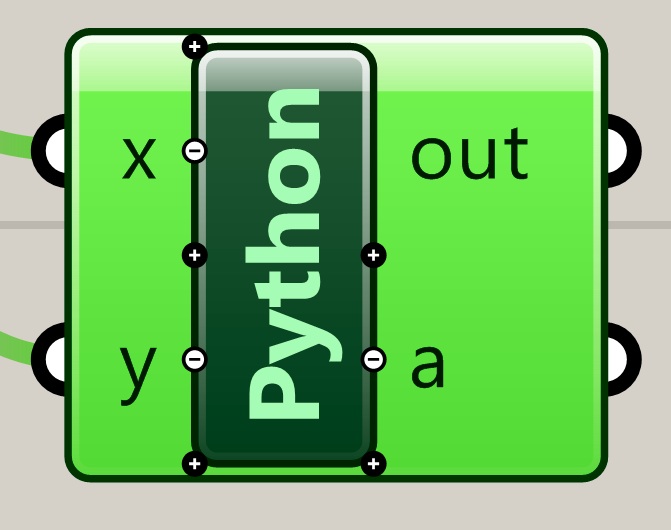
Now, double-click on the Python component symbol in order to open the editor. Note that it is essentially an emptry text file.
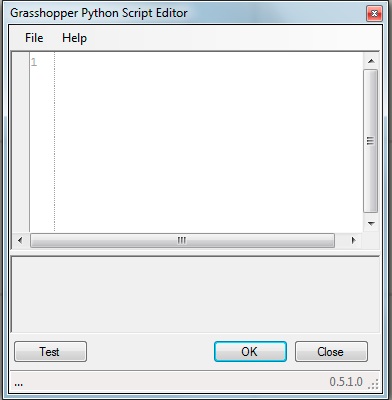
Type
in the
single expression needed to complete the script.
a = str(x + " " + y + "!")

Select the "OK" button on the lower right hand corner of the script
editor to conclude editing the script. Go back to the "Params" tab and
to "Input" area, select the yellow panel , add it to the
right of
the Python script within the Grasshopper view window.

Connect the output port "a" of the Python script to the yellow panel to
see the output.

Note that it is generally quite useful to document the purpose, input
and output functions of the Python script with comment lines. Comment
lines are not executed and are preceded by a number symbol # (e.g., #This
is a comment
line). For
example, double-click on the Python component,
and add the comment line
#Returns
"Hello World!
#INPUT:
string x "hello" and y "world"
#OUTPUT: a
concatenates x and y
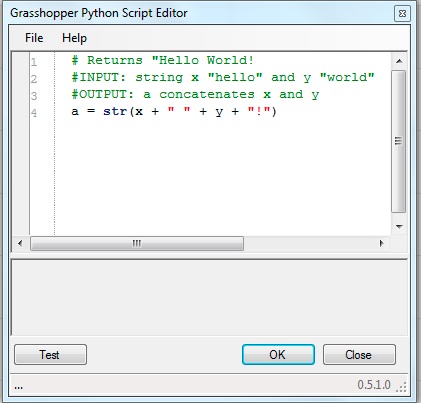
The Python script to construct two numbers is constructed in a similar
way. Go to the "Params" tab and from the "Input" and a number slider.
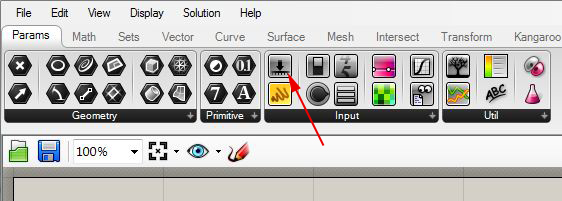
Drag two number sliders into the Grasshopper view window. Now, similar
to the "Hello World" example, go to the Math "Tab" and from the
"Script" area drag Python component with the left-mouse
button
into the Grasshopper view window and connect its input ports to the
output ports of the two number slider components.

Zoom into the Python component , right-click on the letter
"x",
go the the "Type hint" item, and change the type to "Double". Do the
same for the letter "y" variable. Double click on the Python symbol in
order to open the editor. Note once again that the editor is
essentially an empty file.

The following comment lines and expressions are now added to complete
the script and return the result in the variable a.
#Adds
Two Numbers
#INPUT:
numbers x and y
#OUTPUT:
sum of x and y
a = x + y
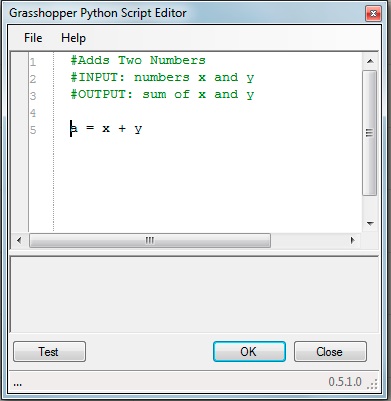
Finally,
select the "OK" button on the lower right hand corner of the script
editor to conclude editing the script. Go back to the "Params" tab and
to
"Input" area, select the yellow panel , add it to the right of the
Python
script within the Grasshopper view window. Connect the output
port "A" of the
script to the yellow panel to obtain the final result of the script.

2.
Scripts to Draw a Few Graphic Primitives
Within the previous set of Grasshopper workshop notes (workshop 8), we covered how to generate a line from two points. Here we perform the same task by using a Python script to produce a grasshopper file makeSimpleLine.gh.
Initiate the script within Rhino by creating two points in the x, y ground plane.
Within Grasshopper, go to the "Params" tab and within the "Geometry" area, select and drag two point icons into the work area.
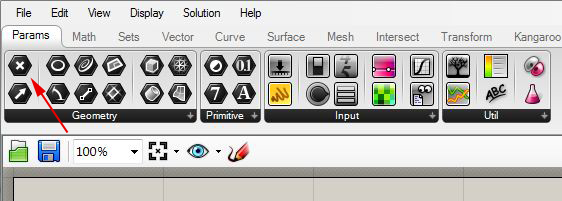
Right-click on each of the two points and use the "set on point" option to connect them to the points created on the x, y plane.
Next, similarly to "Hello World" example above, go the "Math" tab and within the "Script" area drag a "Python" component into the Grasshopper View window.

Double-click on "Python" of the Python scripting component, go to the script editor, and add the following expressions:
Add the following lines to load relevant software libraries
import
rhinoscriptsyntax as rs
import
Rhino as rc
import
math
Add
the following
comment lines at the beginning of the script:
#Draws
a
linefrom two points
#sINPUTS: Two points
#OUTPUT: A line determined by the two points
Add the following statements after the comment lines:
a
= rs.AddLine(point1, point2)
Within the script editor we see the following result:
This completes the script and resulting line should now appear inside Rhino.
Move either of the two points and the line is modified accordingly.
The same script can be modified to draw a rectangle, makeSimpleRectangle.gh, from the initial end points.
First, note that we can extract the coordinates x1, y1, z1 from point1 and the coordinate x2, y2, and z2 from point2. We can combine the two sets of coordinate to get the four points cornerPt1, cornerPt2, cornerPt3 and cornerPt4, that detemine the rectangle. Assuming that both point1 and point2 are in the x-y plane, also note that z1 = z2. That is, we have the following way to establish the values of the four corner points.
cornerPt1
- based
upon x1, y1, z1
cornerPt2 - based upon x2, y1, z1
cornerPt3 - based upon x2, y2, z1
cornerPt4 - based upon x1, y2, z1.
With this in mind, we can edit the Python script as indicated below to get a rectangle. Note that comment lines added to the script describe what is achieved by each step.
#'Draws
a
rectangle from two points
#'INPUTS: Two points
#OUTPUT: A polyline (rectangle) determined by the two
points
#Create
the
corner points from the
x, y, and z coordinates of
point1 and point2
cpt1 = rc.Geometry.Point3d(point1.X, point1.Y, point1.Z)
cpt2 = rc.Geometry.Point3d(point2.X, point1.Y, point1.Z)
cpt3 = rc.Geometry.Point3d(point2.X, point2.Y, point1.Z)
cpt4 = rc.Geometry.Point3d(point1.X, point2.Y, point1.Z)
#Add
the
first corner point from the
x, y, and z coordinates of
point1 to complete the polyline
cpt5 = rc.Geometry.Point3d(point1.X, point1.Y, point1.Z)
#Create
the polyline from the
list of points
line1 = rs.AddPolyline([cpt1, cpt2, cpt3, cpt4, cpt5])
#Return the polyline
from the Python script
a = line1
The
script editor
is now modified as follows.
The script as now completed draws a rectangle. Note that moving the lower left corner point from within Rhino dynamically redraws the rectangle.
Looking at this script in greater detail, observe that we have embedded a point list [cpt1, cpt2, cpt3, cpt4, cpt5] withing the statement
line1 = rs.AddPolyline([cpt1, cpt2, cpt3, cpt4, cpt5])
We add the lower-left point to both the beginning and the end of the list to ensure that we get a closed polyline..Note too that we introduced a polyline object variable with the statement line1 = rs.AddPolyline
The polyline object line1 is thus initialized with the listing of points.
3. Script That Uses Iteration to Express Recurring RelationshipTo draw a series of inwardly rotating polylines makeInwardlyTurningRectangle.gh from the outer rectangle, with each new rectangle in the series stepping upward in elevation, we need to repeat a similar operation a specified number of times.
Note that in the figure above, each inner polyline is calculated from point that is 40% along along each of the four sides of the next outer polyline. In the Python script used to generate this figure, a technique referred to as iteration is used to repeat the same process a given number of times. A number of such iterative techniques exist within the Python scripting language. Within the current example, we use a "while" expression that loops continuously through a series of indented expressions during the time that some integer " i" increments in value from 1 to the number times we we want to repeat loop. In "pseudo-code" (not Python actual code, but more general words), the "while" statement has the following format :
while
(i <=
iterations) :
.... Create a new polyline from the four points
.... Add the polyline to a list of polylines
....Calculate four points of each new polyline
Note that the "while" statement only includes the indented statements which follow it.
First, lets begin by adding to new parameters to the Grasshopper Script from Part 3. Go to the "Params" tab and in the "Input" area add two numerical sliders to the Grasshopper view window.
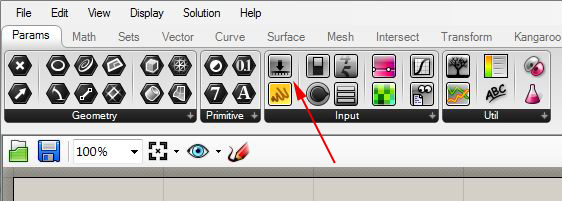
Double-click on the word "slider" and rename the numerical sliders iterations, param Dist, and stepSize. Adjust the iterations slider so that it ranges in value from 0 to 20, and adjust the type to"N" (integer numbers).The paramDist slider by default ranges in value from 0.0 to 1.0, which we can use to represent 0% to 100% of the distance along any side of the last outer polygon. Similarly, the stepSize slider by default ranges in value from 0.0 to 1.0, which we can use to represent the elevation change of each inner rectangle above the outer rectangle that preceded it..
Zoom up on the Python script symbol until "+" symbols appear below the input variables "point1" and "point2".
Select the "+" symbol below "point2" to add a variable "paramDist". Change the default name of "x" to "paramDist" and change the Type hint option to "Double". Similarly, select the "+" symbol below "paramDist". Change the default name of "x" to "numTimes" and change the Type hint option to "Integer".
Next, connect the output ports of the two numerical sliders to the new
input variables of the Python script.
Now, to create the series of rectangles we edit the Python script to incorporate the following text. Comment lines preceded by a # describe what each step of the Python script does.
import
rhinoscriptsyntax as rs
import
Rhino as rc
import
math
#Draws
a series of rotating
rectangles from two points
#INPUTS:
Two points
#OUTPUT:
A line determined by
the two points
#initiate
a polyline list
lines
= [ ]
#derive
x,y,z values of four
corner points from two input points
x1
= CornerPt1.X
y1
= CornerPt1.Y
z1
= CornerPt1.Z
x2
= CornerPt2.X
y2
= CornerPt1.Y
z2
= CornerPt1.Z
x3
= CornerPt2.X
y3
= CornerPt2.Y
z3
= CornerPt2.Z
x4
= CornerPt1.X
y4
= CornerPt2.Y
z4
= CornerPt2.Z
#initiate
four corner points
cpt1
=
rc.Geometry.Point3d(x1, y1, z1)
cpt2
=
rc.Geometry.Point3d(x2, y2, z2)
cpt3
=
rc.Geometry.Point3d(x3, y3, z3)
cpt4
=
rc.Geometry.Point3d(x4, y4, z4)
cpt5
=
rc.Geometry.Point3d(x1, y1, z1)
#initiate
counter
i
= 0
while (i < iterations):
#create a
polyline from the four corner points
line1 =
rs.AddPolyline([cpt1, cpt2, cpt3, cpt4, cpt5])
#append the
polyline to the polyline list
lines.append(line1)
#get x, y, z
values of interior points along each segement of the polyline
xm1 =
cpt1.X + (cpt2.X - cpt1.X) * t
ym1 =
cpt1.Y + (cpt2.Y - cpt1.Y) * t
zm1 =
stepSize + cpt1.Z + (cpt2.Z - cpt1.Z) * t
xm2 =
cpt2.X + (cpt3.X - cpt2.X) * t
ym2 =
cpt2.Y + (cpt3.Y - cpt2.Y) * t
zm2 =
stepSize + cpt2.Z + (cpt3.Z - cpt2.Z) * t
xm3 =
cpt3.X + (cpt4.X - cpt3.X) * t
ym3 =
cpt3.Y + (cpt4.Y - cpt3.Y) * t
zm3 =
stepSize + cpt3.Z + (cpt4.Z - cpt3.Z) * t
xm4 =
cpt4.X + (cpt1.X - cpt4.X) * t
ym4 =
cpt4.Y + (cpt1.Y - cpt4.Y) * t
zm4 =
stepSize + cpt4.Z + (cpt1.Z - cpt4.Z) * t
#reset corner
points to the new set of points
cpt1 =
rc.Geometry.Point3d(xm1, ym1, zm1)
cpt2 =
rc.Geometry.Point3d(xm2, ym2, zm2)
cpt3 =
rc.Geometry.Point3d(xm3, ym3, zm3)
cpt4 =
rc.Geometry.Point3d(xm4, ym4, zm4)
cpt5 =
rc.Geometry.Point3d(xm1, ym1, zm1)
#advance
counter for loop
i = i + 1
#return the list of
polylines from the Python script
a = lines
The Script Editor now appears as follows.
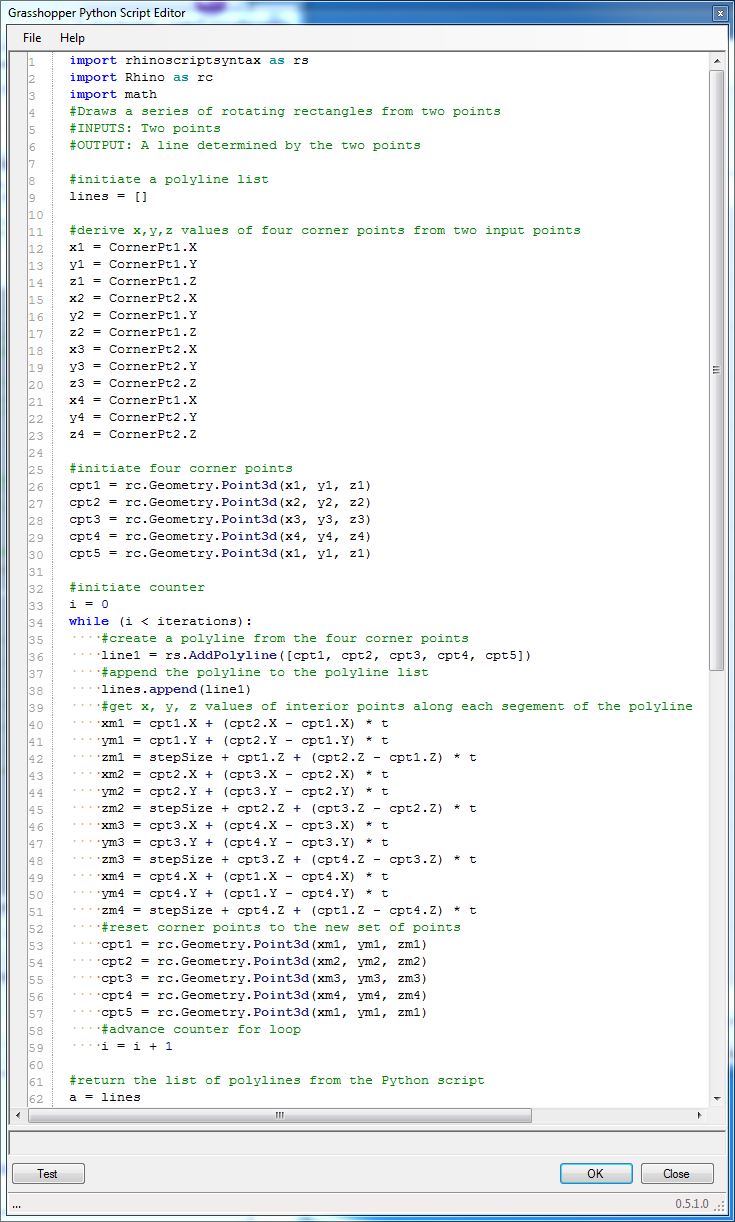
The set of polylines output of the Python script can be input onto a surfaces component in order to convert the series of rotating rectangles into a seres of rotating surfaces. Go to the "Surface" tab in grasshopper, and select the "Boundary Surfaces" component.
Connect the output port "a" to the input port "b" of the bounary surface conmponent to generate the series of rotating surfaces.
3.
Script That Uses Iteration to Generate A Helix
To draw a series of inwardly rotating polylines form the outer rectangle, we needed to repeat a similar operation a specified number of times. Similar to the rotating figure above, a helix, such as determined by, adjustableHelixPython.gh, can also be described by a loop. The vertices that are used to define the spiral are also created in a repeated operation for a specified number of times.
Using tools described previously, initiate the helix by placing two point parameters with a Grasshopper window, and by also adding four numerical slider parameters. One point will be used to identify the center of the spiral. The second point will be used to define the radius. The following sliders should have the following value types and ranges:
| Name of Slider | Description | Type | Min Value | Max Value |
| numRev | number of revolutions in the spiral | Integer (N) | 1 | 25 |
| numSide | number of sides in each revolution of the sprial | Integer (N) | 3 | 360 |
| heightIncrement | height increment in each revolution of the spiral | Floating Point (R) | 0 | 25 |
| radiaIncrement | radius increment in each revolution of the sprial | Floating Poing(R) | -25 | 25 |
Next, connect the points in Rhino to the point
input
parameters, as done
in previous examples. The two points will serve as the center point and
radial point of the sprial.
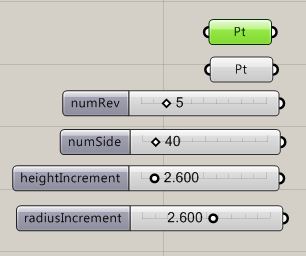
Now, add a Python script component to the Grasshopper View window and add the following input variables and types (use the Type hint feature as done in earlier examples):
| Name of Variable | Description | Type hint |
| centerPt | center point of helix | Point3d |
| radiusPt | radial point of helix | Point3d |
| numRev | number of revolutions in the spiral | int |
| numSide | number of sides in each revolution of the sprial | int |
| heightIncrement | height increment in each revolution of the spiral | float |
| radiaIncrement | radius increment in each revolution of the sprial | float |
Note that the sliders for numRev and numSide ares specified at int (integers), but that the input variables numRev and numSide are specified as float (i.e. floating point numbers). Thus the values are converted from integers to floating point numbers when connected to the Python script. The integer designation for the sliders ensures that only whole numbers are selected. This conversion to floating point numbers ensures that floating point accuracy is maintained in the Python script where needed in some operations.
Finally, double-click on the Phthon script and add the following expression into the script editor.
import
rhinoscriptsyntax as rs
import Rhino as rc
import math
#draws
a helix
#INPUTS:
#centerPt
and radiusPt of helix
#numRev
= number of revolutions
in helix
#numSide
= number of sides per
revolution
#heightIncrement
= height
increment per revolution
#radialIncrement
= radius
increment per revolution
#OUTPUT:
#a
= pline = polyline
approximation of helix curve
#Declare
variables for spiral
point list, vector from center pt to radius pt, and radius
ptList = []
radialVector = rs.VectorCreate(radiusPt, centerPt)
radius = rs.VectorLength(radialVector)
#Declare
variable to hold
incremental values of rotation angle, height and radius for each point
in the spiral
angleIncrement = 360.0/numSide
ptHeightIncrement = heightIncrement/numSide
ptRadialIncrement = radialIncrement/numSide
#Declare
variable to hold the
initial values for the angle, height and radius
curAngle = 0
curHeight = 0
curRadius = radius
#Loop
to generate points in the
spiral
i = 1
#initiate counter for loop
while ( i < numRev * numSide) :
x = centerPt.X +
math.cos(math.radians(curAngle)) *
curRadius
y = centerPt.Y +
math.sin(math.radians(curAngle)) *
curRadius
z = centerPt.Z + curHeight
curPt = rs.AddPoint(x, y, z)
#Add each
successive point to the point list
ptList.append(curPt)
#Advance the
values of the current angle, current height and current radius for the
next point in the spiral
curAngle = curAngle + angleIncrement
curHeight = curHeight + ptHeightIncrement
curRadius = curRadius + ptRadialIncrement
i = i + 1 #increment loop counter
#Determine
a polyline from the
point list
pline = rs.AddPolyline(ptList, replace_id=None)
#Return
the polyline to Rhino
a = pline
Select the "OK" button in the editor and the Grasshopper file will produce the helix as depicted in the following image.

4.
Script That Uses Iteration to Generate A Ramp
The helix script can be enhanced to become todraw two spirals that form a ramp, as illustrated by the Grasshopper file adjustableRampPython.gh.The essential strategy for looping through vertices is the same. Begin by adding a radial point within Rhino to determine the location of the second helix.
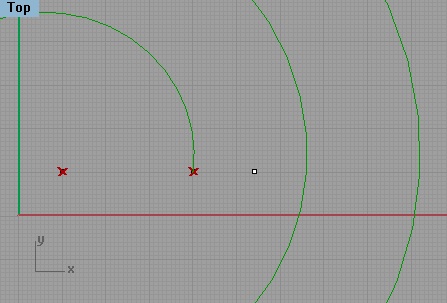
Next, within Grasshopper add a new point input parameter radialPt2 and
connect it to the recently added radial point, and a corresponding
Point3D variable "radiusPt2" to the Python script.
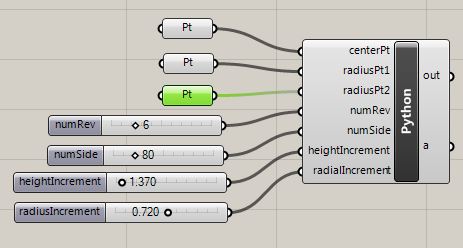
Within the Python script, we now double up on the points so as to produce two spirals rather than one spiral. Furthermore, rather than use the points to form a polyline as in the previous example of the helix, we use them to form two bspline curves. Next, the bspline curves are used to generate a ruled surface. Whereas polylines can not be used to generate a ruled surface, the bspline curves can be used to generate one.
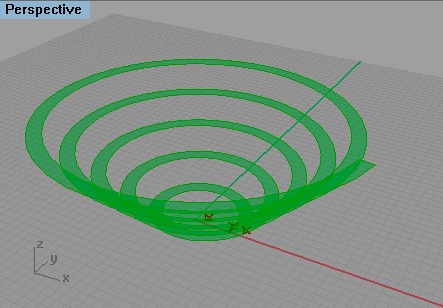
The
Python scrip
is
modified as follows. See the comment lines below for details:
import
rhinoscriptsyntax as rs
import Rhino as rc
import math
#draws
a helix
#INPUTS:
#centerPt
and radiusPt of helix
#numRev
= number of revolutions
in helix
#numSide
= number of sides per
revolution
#heightIncrement
= height
increment per revolution
#radialIncrement
= radius
increment per revolution
#OUTPUT:
#a
= pline = polyline
approximation of helix curve
#Declare
variables for spiral
point list, vector from center pt to radius pt, and radius
ptList
= []
ptList2 = []
radialVector = rs.VectorCreate(radiusPt1, centerPt)
radius1 = rs.VectorLength(radialVector)
radialVector2 = rs.VectorCreate(radiusPt2, centerPt)
radius2 = rs.VectorLength(radialVector2)
#Declare
variable to hold
incremental values of rotation angle, height and radius for each point
in the spiral
angleIncrement = 360.0/numSide
ptHeightIncrement = heightIncrement/numSide
ptRadialIncrement = radialIncrement/numSide
#Declare
variable to hold the
initial values for the angle, height and radius
curAngle = 0
curHeight = 0
curRadius = radius1
curRadius2 = radius2
#Loop
to generate points in the
spirals
i = 1 #initiate
counter for loop
while ( i < numRev * numSide) :
x = centerPt.X +
math.cos(math.radians(curAngle)) *
curRadius
y = centerPt.Y +
math.sin(math.radians(curAngle)) *
curRadius
z = centerPt.Z + curHeight
curPt = rs.AddPoint(x, y, z)
x2 = centerPt.X +
math.cos(math.radians(curAngle)) *
curRadius2
y2 = centerPt.Y +
math.sin(math.radians(curAngle)) *
curRadius2
z2 = centerPt.Z + curHeight
curPt2 = rs.AddPoint(x2, y2, z2)
#Add each
successive point to the point list
ptList.append(curPt)
ptList2.append(curPt2)
#Advance the values of the current
angle, current
height and current radius for the next point in the spiral
curAngle = curAngle + angleIncrement
curHeight = curHeight + ptHeightIncrement
curRadius = curRadius + ptRadialIncrement
curRadius2 = curRadius2 +
ptRadialIncrement
i = i + 1
#increment loop counter
#Determine
a polyline from the
point list
pline = rs.AddPolyline(ptList, replace_id=None)
pline2 = rs.AddPolyline(ptList2, replace_id=None)
#Build
lofted surface between
two curves
rampSurf = rs.AddLoftSrf([pline, pline2])
a = rampSurf
f#Build
lofted surface between two curves
rampSurf = rs.AddLoftSrf([pline, pline2])
In particular we used a function library "rs.AddLoftSrf". A number of functions have been created for Grasshopper to generate geometry and handle other requirements. The current listing of functions and related examples can be found in the web site: http://wiki.mcneel.com/developer/python
5. Python Scripts That Include Sub Functions
The previous examples rely upon scripts that contain one main function each. However, in some circumstances, the logic of a Python script may be more concisely organized into to include sub functions to perform more specific tasks. This is the case of a script, makeQuadripartiteVaultPython.gh, that generates a quadripartite vault from four corner points on the x-y ground plane.
The basic components of the script are the same as what was used in previous examples for this set of workshop notes. Four "pt" components are linked to the four points on the ground in counter-clockwise order. A numerical slider that ranges in value from -5 to 5 is used to determine the height difference if any between the central crossing arches and the side archest of the vault. The Python script accepts the four ground points and height difference number as inputs. It returns the vault surfaces as output.
Note that on the right-hand side of the Grasshopper window, a yellow panel is used to echo back the output of the function. To place such as yellow panel inside the Grasshopper window, go to the "Params Tab"and the "Input Area", select a yellow panel and connect to the output of the Python script
Within the Python script There are "def" functions to perform more of the explicit tasks called upon by the main body of code. In this example, the construction of the quadripartite vault follows a seven step sequence of:
1.
Start with the
four corner points on the ground in counter-clockwise order
(lower-left, lower-right, upper-right, upper-left)
2. Determine the center of the vault on the ground
3. Determine the center arches apex point
4. Determine the side arches apex points
5. Determine the central crossing arches
6. Determine the side crossing arches
7. Loft vault surfaces between corresponding arches
import rhinoscriptsyntax as rs
import Rhino as rc
import math
#Creates A Quadripartite Vault from four points on the the Ground (x-y plane)
#INPUTS: corner points on ground LlowerLeftPt, lowerRightPt, upperRightPt, upperLeftPt
#deltaHeightCtr = difference betweend apex height of central crossing arch and apex of side arches
#OUTPUTS: Surflist = list of eight quadripartite surfaces
def GetCentroid(lowerLeftPt, lowerRightPt, upperRightPt, upperLeftPt):
#Determine centroid of four point
x = (lowerLeftPt.X + lowerRightPt.X + upperRightPt.X + upperLeftPt.X) / 4.0
y = (lowerLeftPt.Y + lowerRightPt.Y + upperRightPt.Y + upperLeftPt.Y) / 4.0
z = (lowerLeftPt.Z + lowerRightPt.Z + upperRightPt.Z + upperLeftPt.Z) / 4.0
centroidPt = rc.Geometry.Point3d(x, y, z)
return centroidPt
def GetCtrApexPt(lowerLeftPt,lowerRightPt,upperRightPt,upperLeftPt,CentroidPt):
#Determine central apex point based upon corner point of vault, centroid on ground and CtrApexPt
#Determine vectors between opposite corner points on ground and get their respective lengths
vect1 = rs.VectorCreate(upperRightPt, lowerLeftPt)
dist1 = rs.VectorLength(vect1)
vect2 = rs.VectorCreate(upperLeftPt, lowerRightPt)
dist2 = rs.VectorLength(vect1)
#Determine the radius of the central cross arches based upon the average distance between opposite ground corner points
radius = (dist1 + dist2) / 4.0
CtrApexPt = rc.Geometry.Point3d(CentroidPt.X, CentroidPt.Y, CentroidPt.Z + radius)
return CtrApexPt
def GetSideApexPt(EndPoint1, EndPoint2, CtrApexPt, deltaHeightCtr):
#Determine side apex point based upon springing points of side arches, central apex point, and height difference if any with central apex point
midPt = rc.Geometry.Point3d((EndPoint1.X + EndPoint2.X) / 2.0, (EndPoint1.Y + EndPoint2.Y) / 2.0, (EndPoint1.Z + EndPoint2.Z) / 2.0)
SideApexPt = rc.Geometry.Point3d(midPt.X, midPt.Y, midPt.Z + CtrApexPt.Z + deltaHeightCtr)
return SideApexPt
def MakeArcs(EndPoint1, ApexPt, EndPoint2):
#Determine crossing arch halves CrossArcA and CrossArcB
#Determine up vector tangent to arc at springing point
UpVec = rc.Geometry.Vector3d(0,0,1)
#Determine arches from endpoints and tangent vector
Arc1 = rc.Geometry.Arc(EndPoint1, UpVec, ApexPt)
Arc2 = rc.Geometry.Arc(EndPoint2, UpVec, ApexPt)
#Convert arc to arc-curve for compatibility with loft tool
Arcc1 = rc.Geometry.ArcCurve(Arc1)
Arcc2 = rc.Geometry.ArcCurve(Arc2)
arcs = []
arcs.append(Arcc1)
arcs.append(Arcc2)
return arcs
def GenVaultSurf(Arc1, Arc2):
#Loft surface between corresponding arccurves
vaultSurf = rs.AddLoftSrf([Arc1, Arc2])
#return first element of vaultSurf list - the actual surface generated
return vaultSurf[0]
#Declare list variable for all surfaces
SurfList = [ ]
#Get the center of the vault on the ground
CentroidPt = GetCentroid(lowerLeftPt, lowerRightPt, upperRightPt, upperLeftPt)
#Determine the center arches apex point
CtrApexPt = GetCtrApexPt(lowerLeftPt, lowerRightPt, upperRightPt, upperLeftPt, CentroidPt)
#Determine each side arch apex point point
SideApexPt1 = GetSideApexPt(lowerLeftPt, lowerRightPt, CtrApexPt, deltaHeightCtr)
SideApexPt2 = GetSideApexPt(lowerRightPt, upperRightPt, CtrApexPt, deltaHeightCtr)
SideApexPt3 = GetSideApexPt(upperRightPt, upperLeftPt, CtrApexPt, deltaHeightCtr)
SideApexPt4 = GetSideApexPt(upperLeftPt, lowerLeftPt, CtrApexPt, deltaHeightCtr)
#Determine the central crossing arch halves
arcList1 = MakeArcs(lowerLeftPt, CtrApexPt, upperRightPt)
CrossArc1a = arcList1[0]
CrossArc1b = arcList1[1]
arcList2 = MakeArcs(upperLeftPt, CtrApexPt, lowerRightPt)
CrossArc2a = arcList2[0]
CrossArc2b = arcList2[1]
#Determine the side arch halves
arcList3 = MakeArcs(lowerLeftPt, SideApexPt1, lowerRightPt)
EndArc1a = arcList3[0]
EndArc1b = arcList3[1]
arcList4 = MakeArcs(lowerRightPt, SideApexPt2, upperRightPt)
EndArc2a = arcList4[0]
EndArc2b = arcList4[1]
arcList5 = MakeArcs(upperRightPt, SideApexPt3, upperLeftPt)
EndArc3a = arcList5[0]
EndArc3b = arcList5[1]
arcList6 = MakeArcs(upperLeftPt, SideApexPt4, lowerLeftPt)
EndArc4a = arcList6[0]
EndArc4b = arcList6[1]
#Loft surfaces between corresponding side-arch half and central crossing arch-half and add to SurfList
vaultSurf = GenVaultSurf(EndArc1a, CrossArc1a)
SurfList.append(vaultSurf)
vaultSurf = GenVaultSurf(EndArc1b, CrossArc2b)
SurfList.append(vaultSurf)
vaultSurf = GenVaultSurf(EndArc2a, CrossArc2b)
SurfList.append(vaultSurf)
vaultSurf = GenVaultSurf(EndArc2b, CrossArc1b)
SurfList.append(vaultSurf)
vaultSurf = GenVaultSurf(EndArc3a, CrossArc1b)
SurfList.append(vaultSurf)
vaultSurf = GenVaultSurf(EndArc3b, CrossArc2a)
SurfList.append(vaultSurf)
vaultSurf = GenVaultSurf(EndArc4a, CrossArc2a)
SurfList.append(vaultSurf)
vaultSurf = GenVaultSurf(EndArc4b, CrossArc1a)
SurfList.append(vaultSurf)
a = SurfList
nd Sub
Sub
functions are
defined to:
2. GetCtrApexPt: Find the central apex point of the vault.
3. GetSideApexPt: Find the apex point of the side arches relative to the central apex point.
4. MakeArcs: Make arcs for each of the side and central crossing arches
5. GenVaultSurf: Generate vault surfaces between each corresponding side-arch half and central crossing arch half.
Note that each of the sub functions (defined forllowing the key word "def") has input data passed to them by means of variables, and returns data by means of a return statement, similar how the main body of the script has input data passed to it and returns data.
The main body of the script is somewhat like a general contractor that oversees overall workflow, and indeed can be conceived of without being focused on the details. The sub functions are like sub-contractors and employed multiple times within the overall process where needed. Given how the geometry has been defined, it is possible to move any of the ground points and determine a more asymmetrical vault.
Or, by entering a series of points, it is possible to replicate the arrangement of a nave, crossing, or ambulatory.
